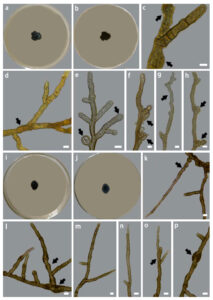Intumescentia vitii H.L. Si, R.L. Chang, T. Bose & Y.C. Wang, in Si, Wang, Liu, Li, Bose & Chang, Journal of Fungi 9(4, no. 423): 11 (2023)
Index Fungorum Number: IF 844854, MycoBank Number: MB 844854, Facesoffungi Number: FoF 15841
Etymology – Named after its host lichen species, Physcia vitii.
Holotype – China, Yunnan Province: Tiesuo Township, 26°32′71” N, 100°57′3” E, ca.2115 m elev., isolated from Physcia vitii, 17 January 2021, H.L. Si, CX89C2 (HMAS 352148, Holotype), ex-type Culture CGMCC3.23741, GenBank: ITS: OP342841, LSU: OP345120, SSU: OP345110, ACT: OP354481, CAL: OP354487, RPB2: OP354475, TEF1: OP354469.
Description – Hyphae are smooth, dark brown in color, branched, septate, with constricted septa; the compartment is often peanut-shaped, multi-guttulate with guttles small in size; the compartment is variable in size and often distorted, measuring 2.64–7.31 μm (x̄ = 4.09 μm, n = 50), usually with irregular globose hyphal swellings that are intercalary in position, with lateral branching usually arising below the septa. Juvenile hyphae and hyphal apices are thin-walled and hyaline to light brown in color; matured hyphae have thick walls and are dark brown in color. Asexual and sexual structures were not observed.
Colony morphology and growth – Colony on PDA after 30 days at 25 °C is blackish brown in color (top and reverse), compact, superficial, tomentose, and margins are entire and irregularly lobed. Optimal growth temperature is 25 °C (0.18 mm/day). Growth was observed at 5 °C (0.06 mm/day), whereas no growth was detected at 35 °C.
Notes – Intumescentia vitii appeared as the sister of I. tinctorum in the ML (Figure 1), MP, and BI trees. These two species exhibit characteristics that are both overlapping and distinctive (Table 1). In addition to the DNA data, these two species can be differentiated through colony morphologies, hyphal dimensions, and optimal growth temperatures.

Figure 1 – Colony morphology of Intumescentia vitii sp. nov. (CGMCC3.23741) on PDA medium after 30 days at 25 °C, (i) top, (j) reverse, hyphal morphology (k) peanut-shaped compartments, (l–p) a variety of swollen and distorted compartments with branches emerging from the base of septa. Bars = 5μm. Morphological structures listed above are indicated with arrows.

Table 1 – Comparison of the morphological characters and growth rate of Intumescentia species recovered in this study.
